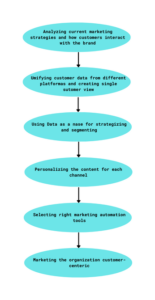- Industries
Industries
- Functions
Functions
- Insights
Insights
- Careers
Careers
- About Us
- Marketing & Advertising
- By Omega Team

E-commerce is now a vital part of the worldwide retail framework. The retail sector, like many other industries, has undergone significant transformation since the advent of technology and the internet. Thanks to the continual digitalization of modern society, consumers from across the world now benefit from the convenience of mobile transactions.
Overview of Global E-commerce Market
More than two billion people procured goods or services online in 2020, and global e-commerce sales exceeded 4.2 trillion US dollars in 2020. This figure is estimated to surpass 6.3 trillion by 2024. According to the country-wise E-commerce sales forecast for 2021, three of the top five markets, expected to contribute to 62.6% of all internet retail, are in the Asia-Pacific region. This makes it an important market for retailers to target. China is leading in e-commerce, with US $ 1.3 billion in sales in 2020, and it is estimated to reach $ 2.7 billion in 2021.
A shift in spending power from the United States and Europe to China and Southeast Asia has commenced, spurred by an increasing number of Asian consumers having access to e-commerce. Amazon ranks first among the world’s leading large-cap e-commerce companies, with a market capitalization of over 1,558.07 billion US dollars. As per March 2021 data, the e-commerce behemoth outranks Alibaba, Prosus, and JD.com. During the period under consideration, Alibaba’s market capitalization was 614.69 billion US dollars.
Figure 1: Retail e-commerce Sales Worldwide from 2014 to 2024

Figure 2: E-commerce Sales by Country

Figure 3: Market cap of leading large cap e-commerce companies worldwide as of March 2021

Competition in the E-commerce industry is unprecedented. The growing volume of Voice search and use of technologies like Augmented reality is transforming how purchases are made. In this scenario, it is crucial that brands stay on their toes and provide the best experience possible, to the customers. Omni-channel Strategy can help the brands to create this experience.
Omnichannel Experience
An omnichannel customer experience is one in which a customer interacts with the brand through different channels as part of a common, streamlined customer journey. Marketing, sales, service and support, and also in-store interactions are all embedded so that a user can easily transition from one customer channel to another to complete their purchase journey.
Difference between Omni-channel and multi-channel
The customer accesses a variety of communication channels in a multi-channel environment, which are not necessarily integrated or interconnected. In an omnichannel experience, there are not only multiple channels, but the channels are linked so that the customer can move from one channel to another seamlessly. Most brands today engage in a multi-channel experience. Nevertheless, in most cases, the buyer still does not have a seamless experience across all of these channels.
Hence it can be said that, while all Omni-Channel experiences employ multiple channels, not all multi-Channel interactions are Omni-Channel.
Why Omnichannel is Important for Online Retailers?
As per a survey conducted in 2020, 46 percent of retail executives intended to increase their investment in omnichannel experience in the future, in comparison to their plans prior to COVID-19. As per a survey conducted by the Harvard Business Review, omnichannel customers spend more than single-channel customers. Spending of Omnichannel customers is 4% more in-store and 10% more online as compared to that of single-channel customers. These are some of the aspects that contribute to the value of the omnichannel experience.
Meeting Customers where they are
Customers are discovering new products and brands through a variety of new channels, including Facebook and Instagram ads, Google Shopping, E-commerce platforms, product reviews, in-store discovery, word of mouth, and many more. They may come across the product/brand while using a personal computer, a TV, or a smartphone. Hence it is important that brands must show up where customers are. This can help to make their shopping experience more convenient. Omni-channel strategies enable online retailers to meet the customers at a platform of their convenience.
Leveraging the Data collected from different channels
A detailed, interconnected omnichannel strategy enables the brands to centralize information from all of their channels. It can help the brands in selecting the most appropriate ways to manage inventory, improve customer relationships in whichever channel they are, and provide the best customer service, regardless of where they shop.
Use data to determine whether any of the following should be reconsidered:
- Product Assortment
- Channels of distribution
- Channels of advertising
- Messaging
Cornerstones of Omnichannel E-Commerce
Sales Channels
With more touch-points to choose from than before, brands need to constantly monitor the audience, where they devote their most time, and where similar products are usually sold. Channels can include:
- Online storefronts/DTC
- E-commerce marketplaces
- Social media platforms
- Mobile channels
- Brick-and-mortar stores-or anywhere you use a POS
- B2B/Wholesale sales
Selection right combination of channels and approaching the customers at the right time can improve results.
Marketing Channels
Customers cannot locate the brands on their own. Regardless of which sales channels are used, even the best products and online platforms require an omni-channel marketing strategy to drive traffic and revenue. The right message delivered just at the correct time and at the right place, all while retaining brand experience, can make a substantial difference in the result. Some of the best digital marketing or advertising channels by online retailers are:
- Google Shopping Ads
- Marketplace advertising
- Retargeting ads
- Social media
- Email and SMS
Operations
Operations include everything like the functions in the back-office, including product, order, and inventory control, order processing, and supply chain management. Interconnection is the crucial component of a functional omni-channel approach from an operational standpoint. The systems that make up back-office activities will vary depending on the size and complexity of the company.
Inventory visibility is arguably the most significant impediment to effective omni-channel inventory management. It can be difficult to access data for appropriate reporting or guarantee customers that the product will be available in stock on all channels. Hence, when brands expand into new channels, it is imperative to have centralized inventory visibility to optimize the supply chain.
The Customer Experience
User experience encompasses everything that occurs during the course of a customer’s relationship with your company. Customer support, user experience (UX), and service offerings, pricing models, Purchase Journey, as well as shipping and logistics, are all part of this. When it comes to buying online, 64 percent of shoppers prioritize customer experience over price. As per The Guardian’s forecast, the value of the user experience that a brand can offer will be more important than price.
The key to providing great customer service is to make everything as simple as possible for customers. An inconvenient return policy prevents 80 percent of shoppers from making a purchase, while 74 percent of customers are likely to shift their brand choices if the buying process is too complicated.
Realizing the importance of Mobile Shopping
According to eMarketer, mobile accounts for 59 percent of all e-commerce sales. For a variety of reasons, there is an increase in mobile purchasing. The reasons include the fact that most people carry smartphones with them wherever they go. Furthermore, flawless customer experience via apps, as well as the proliferation of mobile wallet solutions are making it much easier to purchase on smartphones. It is important to have a mobile-responsive website-a website that automatically adjusts to fit the smartphone. Simplifying the buying process is equally important. It should include auto-filling as much customer information as possible, anything to create the customer’s experience better and the checkout process faster.
Creating a Good Omni-Channel Experience
To create an effective omni-channel experience, it is important to zoom into the existing marketing processes and customer behavior to understand which strategies work. The more well-identified the customer segmentation, the better is the omni-channel marketing strategy. Also, connecting the customer data from the various platforms can provide valuable insights. Also, connecting the customer data from the various platforms can provide valuable insights.
There are numerous ways to reach out to customers, ranging from Email and SMS to push notifications. Nevertheless, before targeting customers through all of the channels, it is better to take a moment and craft a personalized message for each one. It is imperative to make sure that the context of your message is relevant to the user. Sending it to the user when they are most active and on the platform with which they engage the most, can be effective. By displaying relevant ads on social media websites, brands can be able to create top-of-mind recalls, which may increase the likelihood of conversion.
Marketing automation tools help brands in intelligent segmentation, personalization of messages, scheduling different campaigns, and measuring its efficacy. Selecting the right marketing automation tool and utilizing it to the greatest extent possible can lead to incredible results. Let us understand, how The E-commerce Giant – Amazon is harnessing the benefits of Omni-channel strategy.
Figure 4: Steps for building an effective Omni-channel Strategy

Amazon’s Omni-channel Strategy
Amazon’s mission is about being “the most customer-centric company on the planet.” Reaching customers where they are is a part of its implementation. For Amazon, this entails broadening their channels and developing a cohesive omnichannel experience. Amazon’s omnichannel success is based on two key principles. Amazon prioritizes the customer experience. They use data to build personalized, responsive interactions, regardless of the channel through which their customers engage with them. Amazon concentrates on backend channel integration. This is more than just inventory and central fulfillment.
Linking customer data across channels and devices is a challenge. Customer information such as behavior, purchase history, demographic characteristics, product/category inclinations, and other factors are typically segregated in different channels. Amazon Prime is the company’s response to the customer data challenge. Amazon Prime is the best incentive to create an account and log in regardless of which platform or device customers are using. The benefits like Faster and free shipping, unlimited streaming as well as access to tv shows, Prime Wardrobe that allows customers to try on products before buying them online, Free Prime Music Subscription that enables customers to access a collection of 2 million of the most popular tracks for free, and Various discounts, etc. motivates the customers for Account creation.
There are 95 million Amazon Prime members currently. This is in spite of the continuous increase in prices. Amazon Prime eliminates both the major reasons for cart abandonment – Shipping Costs and Account Creation. Amazon Prime enables Data Unification from across the platforms and creates a single customer view which is the mainspring of their Omnichannel strategy.
Conclusion
The convenience of customers is at the center of a good Omnichannel strategy. Customers are time-strapped and for them, convenience is a strong requirement. Furthermore, Consistency of the brand experience on all the platforms helps to boost consumer learning. Providing real-time, localized, and personalized experiences while maintaining consistent brand experience is the key to exceptional Omni-channel experience. Hence it can be said that Customer convenience, Brand Consistency, Brand Relevance, and Agility can drive an effective Omni-channel Experience.
Subscribe
Select topics and stay current with our latest insights
- Functions